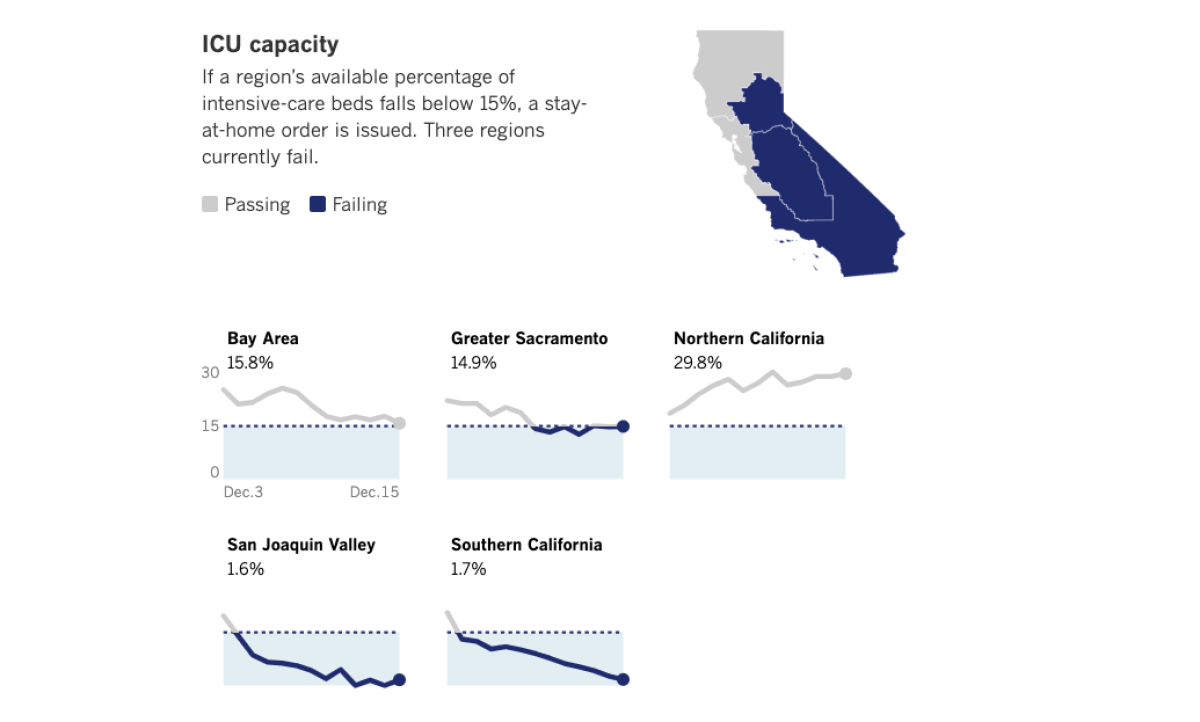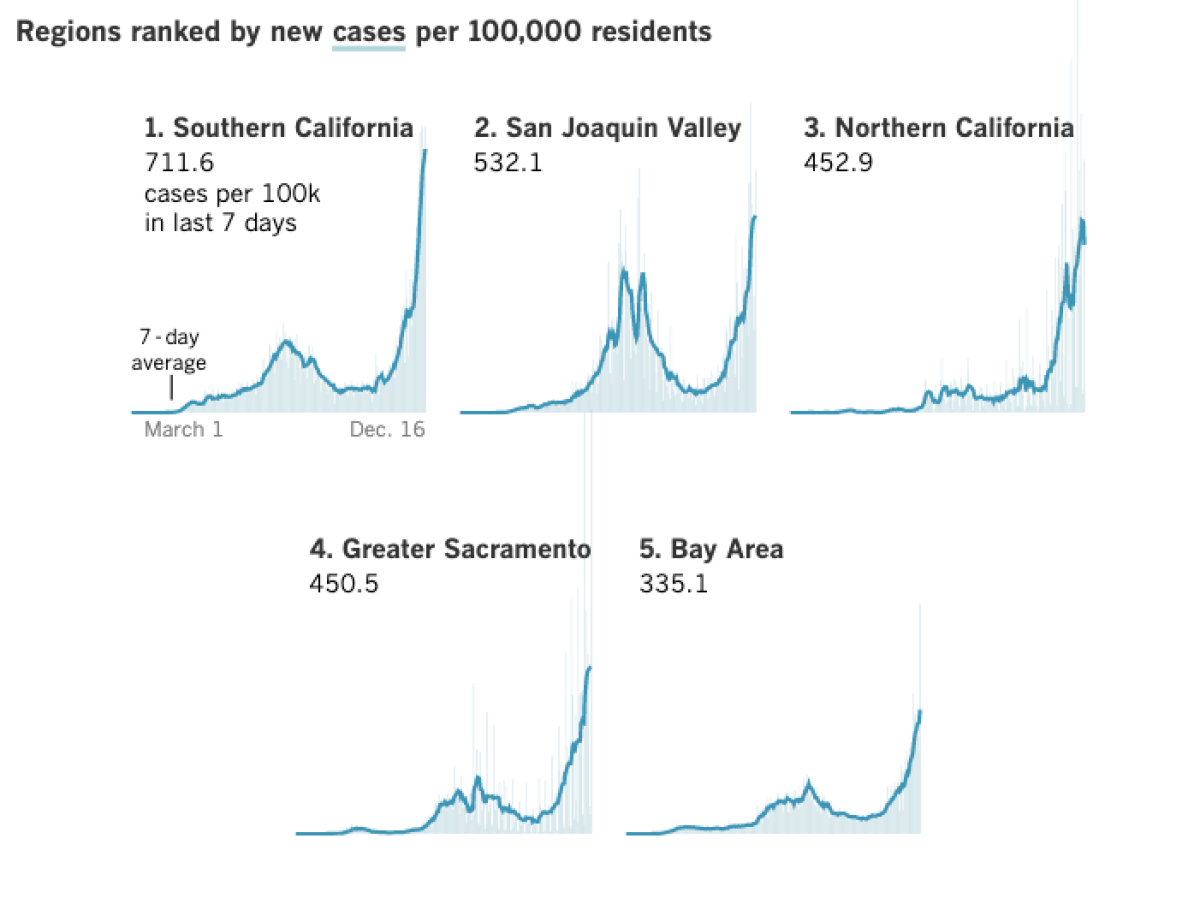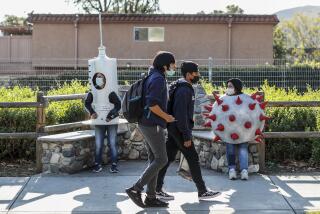California shatters single-day COVID-19 death record, with 295

Tuesday’s statewide COVID-19 death toll was higher than the record tally set only a week ago.
- Share via
SAN FRANCISCO — California has shattered yet another single-day record for COVID-19 deaths: 295, according to the Los Angeles Times county-by-county tally for Tuesday.
That breaks the single-day record last set Dec. 8 and repeated Friday, when 219 deaths were recorded. California is now averaging 175 COVID-19 deaths a day over the last week, a new record for the pandemic in the state.
The record for average daily deaths over a weekly period has been broken for seven consecutive days. The deadliest day of the pandemic thus far in California was fueled by record death tolls in six counties from San Diego up to the Bay Area, according to a Times analysis.
A day of record deaths
Single-day COVID-19 death records were broken Tuesday in the counties of Los Angeles, with 93; San Diego, with 32; Santa Clara, with 24; Yolo, with nine; San Luis Obispo, with six; and Santa Cruz, with five.
L.A. County’s Tuesday total exceeds the record set July 29, when 91 deaths from COVID-19 were reported. San Diego County’s previous high was 26 deaths, which were registered Dec. 8. The Santa Clara County tally surpassed the 13 deaths it recorded Sept. 11.
The alarming figures came hours after Gov. Gavin Newsom disclosed Tuesday that state officials had been forced to order 5,000 body bags and 60 refrigerated storage units, each 53 feet long, for storing corpses. Newsom said he has activated the state’s coroners mutual-aid and mass-fatality program.
“Let’s deal with some sober realities,” Newsom said. “This is a deadly disease. And we need to be mindful of where we are in this current journey together to the vaccine: We are not at the finish line yet.”
California’s daily new coronavirus caseload hits unprecedented heights
Cumulatively, California has now reported 21,495 COVID-19 deaths and 1.65 million coronavirus cases.
The state is now averaging about 32,000 new coronavirus cases a day over the last week — an astonishing eight times more than the daily average in late October.
At the same time, California has far fewer cumulative cases and deaths per capita compared to other states, which experts credit to aggressive stay-at-home orders issued early in the pandemic and repeated, if controversial, business-closure orders, including ones that have kept theme parks shut and largely kept bars and indoor restaurant dining off-limits in hard-hit counties such as Los Angeles.
The death rate in Arizona, which has had far more permissive coronavirus restrictions, is 106 deaths per 100,000 residents — nearly double California’s, which is 54 deaths per 100,000 residents.
But the surge in infections that began in the autumn — likely related to a combination of pandemic fatigue, Thanksgiving celebrations and other factors — has been the worst so far, and threatens to overwhelm the state’s hospital system.
COVID-19 hospitalizations have never been higher: As of Monday, there were 14,283 patients statewide who have tested positive for the coronavirus, including 3,081 in intensive care. The record for COVID-19 hospitalizations has been broken for 17 consecutive days, and the number has more than doubled since Thanksgiving.
On Tuesday, Southern California and the San Joaquin Valley reported the lowest regional available ICU capacity in the entire state: 1.7% and 1.6%, respectively.

Next two weeks critical for California’s hospitals
“We’re going through perhaps the most intense and urgent moment since the beginning of this pandemic,” Newsom said Tuesday.
Dr. Mark Ghaly, the California health and human services secretary, warned that the next two weeks — which include Christmas and New Year’s Day — are forecast to become even more difficult for hospitals already under major strain.
Ghaly said 12% of today’s newly diagnosed coronavirus cases are likely to require hospitalization. “And 12% of those that have been hospitalized are going to end up in our ICU,” he said.
Today’s hospitalizations are actually a reflection of coronavirus cases confirmed two weeks ago, when the average daily number over a weekly period was about 15,000 a day. Now, average daily cases number about 33,000 a day, meaning that pressure on the hospital system by New Year’s Eve is expected to be even greater.
A plea to stay home for Christmas
“That should tell you that in the next couple of weeks, what our hospitals will be facing — the amount of people knocking on the front door with COVID ... that might need that ICU bed — are going to increase,” Ghaly said.
“So even though we talk about today ICU capacity being concerning ... what we are really preparing for is two weeks from now,” he said.
Ghaly said the only way to turn this around is for people to stay home, especially during the Christmas holiday season. Newsom said earlier this week that the regional stay-at-home orders imposed across most of California last week were beginning to show some effect in reducing residents’ movements.
The record death toll in Santa Clara County on Tuesday brought emotion to the voice of Dr. Sara Cody, the veteran health officer and a key architect of the nation’s first regional stay-at-home order, as she made her report to the county Board of Supervisors.
“We cannot normalize this,” Cody said. “It’s become pretty clear that we do need to take more serious action. We need a statewide action to keep people from dying.”
“Our economy will not recover and the small businesses that are suffering — they cannot succeed if their customers and their workers are dying,” Cody said. “And so to breathe life back into all of us, in all aspects of our lives, the one single thing that we must do is to bring the pandemic under control, and to slow it down.”
She acknowledged that people are tired of coronavirus restrictions, “but we have to just continue to soldier forward ... because the virus is everywhere.”
Vietnamese and Filipino Americans hit harder compared to other Asian groups
Latino residents continue to be disproportionately hit by the pandemic in Santa Clara County. And in a new finding, Cody said, disease rates among ethnic Vietnamese and Filipino residents are rising faster compared to other Asian subgroups.
Relatively speaking, the Bay Area is actually performing the best of all of California’s five regions in terms of new coronavirus cases per 100,000 residents, with 335 cases per 100,000 residents over the last week. Southern California is reporting the worst rate, with 712 new cases per 100,000 residents.

‘Dark days ahead’ for Silicon Valley
Nonetheless, the same pandemic fatigue affecting the rest of the state has also hit the Bay Area, and now intensive care units are crowded in the heart of Silicon Valley. Public health teams in Santa Clara County have been inundated with reports of outbreaks in workplaces, long-term care facilities and healthcare facilities; one outbreak involving a youth basketball team that violated a ban on playing at tournaments resulted in more than 75 positive coronavirus cases.
“We have very dark days ahead,” Cody said. “COVID is in fact on a path to be among the five leading causes of death here in our county. So our pandemic locally is out of control ... and our healthcare system is quite stretched — not quite to the breaking point, but steadily marching to that point.”
Adding capacity to hospital staffing will be difficult. Hospitals, said Dr. Ahmad Kamal, Santa Clara County’s director of health preparedness, “continue to have staffing shortages due to exhaustion, due to absenteeism and due to an unprecedented demand throughout the state and nation for qualified nurses and healthcare workers.”
Lin reported from San Francisco, Money and Murphy from Southern California.
More to Read
Sign up for Essential California
The most important California stories and recommendations in your inbox every morning.
You may occasionally receive promotional content from the Los Angeles Times.













